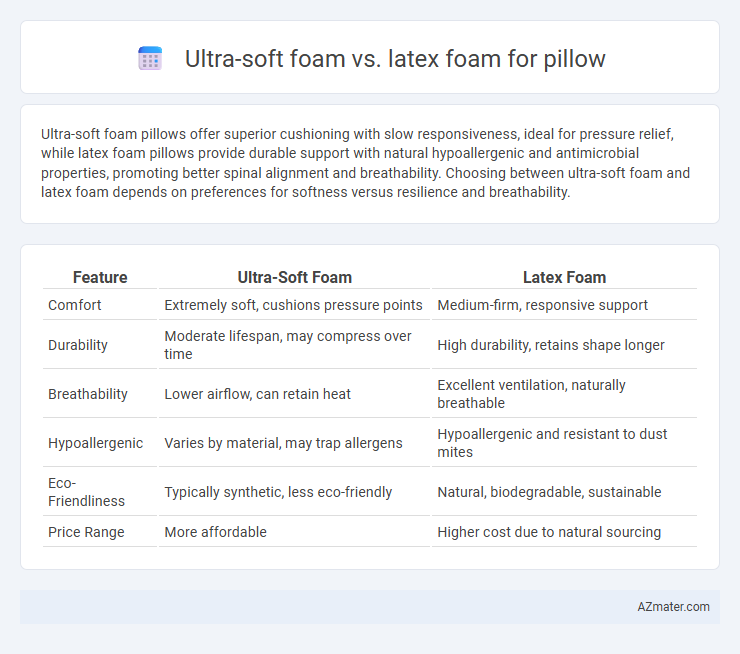Ultra-soft foam pillows offer superior cushioning with slow responsiveness, ideal for pressure relief, while latex foam pillows provide durable support with natural hypoallergenic and antimicrobial properties, promoting better spinal alignment and breathability. Choosing between ultra-soft foam and latex foam depends on preferences for softness versus resilience and breathability.
Table of Comparison
| Feature | Ultra-Soft Foam | Latex Foam |
|---|---|---|
| Comfort | Extremely soft, cushions pressure points | Medium-firm, responsive support |
| Durability | Moderate lifespan, may compress over time | High durability, retains shape longer |
| Breathability | Lower airflow, can retain heat | Excellent ventilation, naturally breathable |
| Hypoallergenic | Varies by material, may trap allergens | Hypoallergenic and resistant to dust mites |
| Eco-Friendliness | Typically synthetic, less eco-friendly | Natural, biodegradable, sustainable |
| Price Range | More affordable | Higher cost due to natural sourcing |
Understanding Pillow Foam Types
Ultra-soft foam pillows offer exceptional cushioning with a low-density structure that conforms closely to the head and neck, providing gentle support ideal for side and stomach sleepers. Latex foam pillows, made from natural or synthetic rubber, deliver firmer support with excellent durability, breathability, and hypoallergenic properties, making them suitable for back sleepers and allergy sufferers. Understanding these foam types helps consumers choose pillows that balance comfort, support, and longevity according to their sleep preferences and health needs.
What is Ultra-soft Foam?
Ultra-soft foam is a type of polyurethane foam engineered to provide exceptional softness and pressure relief, making it ideal for pillows designed to enhance comfort and support. This foam features an open-cell structure that promotes breathability and adapts to the natural contours of the head and neck, reducing stiffness and improving sleep quality. Compared to latex foam, ultra-soft foam offers a more cushiony and pliable feel, while latex foam excels in durability and natural resistance to allergens and dust mites.
What is Latex Foam?
Latex foam is a natural or synthetic material derived from rubber tree sap, prized for its durability, breathability, and natural resistance to dust mites and mold. Its responsive and supportive qualities adapt to the shape of the head and neck, providing consistent spinal alignment without the sinking feeling typical of ultra-soft foam. Compared to ultra-soft foam, latex foam maintains its resilience over time, offering a cooler and hypoallergenic sleep surface ideal for those seeking both comfort and long-lasting pillow support.
Key Differences between Ultra-soft and Latex Foam
Ultra-soft foam pillows provide exceptional cushioning and contour to the head and neck, offering plush comfort ideal for side sleepers, whereas latex foam pillows deliver firmer support with natural elasticity that maintains shape and provides consistent spinal alignment. Latex foam is hypoallergenic, breathable, and resistant to dust mites, making it suitable for allergy sufferers, while ultra-soft foam tends to retain more heat and may compress faster over time. The durability of latex foam surpasses ultra-soft foam, providing long-lasting resilience and enhanced pressure relief without sacrificing support.
Comfort and Support Comparison
Ultra-soft foam pillows provide a plush, cloud-like comfort that contours gently to the head and neck, ideal for those who prefer a softer sleeping surface. Latex foam pillows offer firmer, more resilient support with natural elasticity, maintaining spinal alignment and reducing pressure points effectively. While ultra-soft foam excels in cushioning softness, latex foam outperforms in durability and consistent support for various sleep positions.
Durability and Longevity
Latex foam pillows offer superior durability and longevity due to their natural resilience and ability to maintain shape over time, often lasting up to 8-10 years without significant degradation. Ultra-soft foam pillows, while initially providing plush comfort, tend to compress and lose structural integrity more quickly, generally requiring replacement every 1-3 years. The denser cell structure of latex foam resists sagging and wear, making it a more reliable choice for long-term support in pillows.
Breathability and Temperature Regulation
Ultra-soft foam pillows offer moderate breathability but can retain heat more than latex foam, leading to less effective temperature regulation. Latex foam features an open-cell structure and natural ventilation properties that enhance airflow, promoting cooler sleep and better moisture-wicking. The inherent breathability of latex foam provides superior temperature regulation compared to ultra-soft foam, making it ideal for hot sleepers.
Hypoallergenic and Health Benefits
Ultra-soft foam pillows offer excellent hypoallergenic properties by resisting dust mites, mold, and bacteria, making them ideal for allergy sufferers and asthma patients. Latex foam pillows provide natural antimicrobial and antifungal benefits due to their organic composition, promoting better airflow and reducing skin irritation. Both materials support spinal alignment and pressure relief, but latex foam is often preferred for its durability and enhanced breathability, contributing to overall respiratory health.
Price and Value Considerations
Ultra-soft foam pillows typically offer a lower price point, making them a budget-friendly choice for consumers seeking immediate comfort. Latex foam pillows, while more expensive, provide superior durability and natural hypoallergenic properties, offering greater long-term value. Evaluating factors such as longevity, allergen resistance, and upfront cost is essential when deciding between ultra-soft foam and latex foam for pillow purchases.
Which Pillow Foam is Best for You?
Ultra-soft foam provides exceptional cushioning and contouring by adapting closely to the head and neck, ideal for side sleepers seeking pressure relief. Latex foam offers natural resilience, breathability, and durability, supporting spinal alignment and reducing heat retention for back and stomach sleepers. Choosing the best pillow foam depends on your sleep position, preferred firmness, and need for temperature regulation or hypoallergenic properties.

Infographic: Ultra-soft foam vs Latex foam for Pillow
 azmater.com
azmater.com